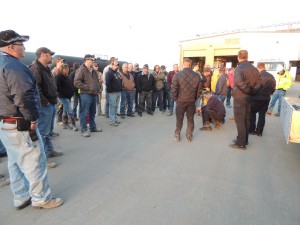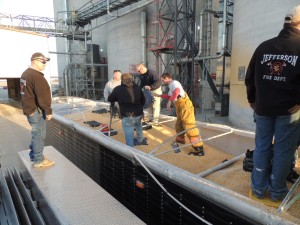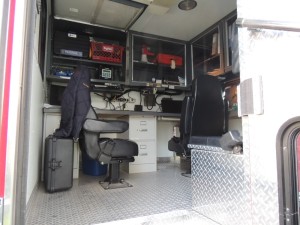 About 30 firemen and emergency responders from Jefferson, Grand Junction, Churdan and Rippey, as well as Greene County EMS, attended a county-wide training March 18 at the Louis Dreyfus ethanol plant in Grand Junction. The event was hosted as part of Louis Dreyfus’s Worldwide Safety Day.
About 30 firemen and emergency responders from Jefferson, Grand Junction, Churdan and Rippey, as well as Greene County EMS, attended a county-wide training March 18 at the Louis Dreyfus ethanol plant in Grand Junction. The event was hosted as part of Louis Dreyfus’s Worldwide Safety Day.
 The firemen spent the first part of the training practicing grain bin extrication in a semi-trailer of corn from West Central Coop. The departments have attended joint training on that previously, and last week’s exercise was to refresh skills and share with those who had been unable to attend previous drills.
The firemen spent the first part of the training practicing grain bin extrication in a semi-trailer of corn from West Central Coop. The departments have attended joint training on that previously, and last week’s exercise was to refresh skills and share with those who had been unable to attend previous drills.
Members of the Region V hazmat team were also on hand to give “tours” of their $200,000 truck. According to hazmat team coordinator Tom Ubben, the team is reaching out to emergency responders throughout the nine counties in Region V to be sure they feel comfortable using the team as a resource. Ubben encouraged the responders to call for information early when there’s an incident.
The hazmat team all are firefighters on the Fort Dodge department, the only fulltime, paid fire department in the nine counties served: Greene, Calhoun, Carroll, Hamilton, Humboldt, Pocahontas, Sac, Webster and Wright. Ubben noted that response time to Jefferson from Fort Dodge is an hour minimum, but that in about one-third of the incidents, the local departments are able to handle situations with consultation with the hazmat team.
All area firefighters are trained to handle hazardous material events at the “awareness” level. They can place dikes or put out absorbent material, but if hazmat suits or decontamination are required, they must call the hazmat team.

The hazmat truck does not carry water, but a wide array of chemical test kits, a portable decontamination shower, air transfer pumps and air bottles, rescue struts, railroad chocks, and “anything you can dream of to plug a hole,” Ubben said.
The truck also has a weather station and a command center with wireless internet. Ubben said they can use pictures sent via cellular phones to advise in some situations.
Greene County emergency management director Dennis Morlan is the only founding member of the Local Emergency Planning Committee – the group that initiated Region V and oversees its activities – still serving. Morlan explained that a large lethal chemical spill in Bhopal, India, in 1984 prompted the federal government to require labeling of chemical hazards and planning at the local level for such incidents. With limited resources available in rural counties, he and Jack Frederickson, who was on the board of supervisors at the time, began organizing other counties. The Region V hazmat response team was formed in 1994.
The hazmat team and equipment is funded by a $1 per capita fee in each of the nine counties served.
The Region V team responds to an average of 10 calls per year, according to Ubben. He named anhydrous tanks and fuel tankers as the highest risk in the region, and he noted that Highway 20 as a four-lane highway has added to the risk by increasing the amount of traffic and the speed. He also mentioned rail traffic in and out of ethanol and bio-diesel plants as a risk.
